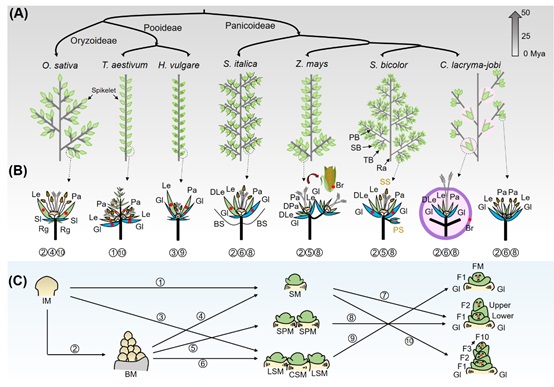Crops have been domesticated by humans for thousands of years, experiencing significant variations in their inflorescences, spikelet, floret, and other floral organs. Most notably among these is the outermost floral organ of the spikelet—glume. In the natural evolution of cereals, seeds are protected by the glume or hull. However, in agricultural production, seeds have consistently faced selective pressure from humans to be easily threshed, which has led to the development of various hull-like floral organs.
Recently, a review led by Professor XIE Qi from the Institute of Genetics and Developmental Biology, Chinese Academy of Sciences, comprehensively synthesized and discussed the evolution process of cereal floral organ and the genetic and molecular networks regulating cereal threshability.
By comparing the representative morphological structures of inflorescences, spikelet, floret, and hull-like floral organ among seven major crops (rice, wheat, barley, millet, maize, sorghum, and coix), similarities are observed in spikelet development within the same genus, while distinct traits exist across different genera. For instance, in the "three-floret spikelet" hypothesis in rice, the original glumes become reduced, with two lateral putative florets developing into hard glumes, known as sterile lemmas. In sorghum and maize, sterile florets evolve into transparent or feathery lemma-like organs.
It is also found crops have evolved diverse floral and hull-like organs, suggesting a balance struck between natural evolution and human selection. The key genes selected for easy-threshing trait during domestication differ but are situated in similar regulatory pathways or within analogous gene families.
Future molecular design breeding of crop easy-threshing trait through utilizing superior natural alleles and gene editing will fast achieve de novo domestication of wild species.
Figure: Schematic diagram of the morphological structure of inflorescences, spikelet, and floret of seven major crops. (Image by IGDB)
Contact:
Professor Qi Xie
Institute of Genetics and Developmental Biology, Chinese Academy of Sciences
 Figure: Schematic diagram of the morphological structure of inflorescences, spikelet, and floret of seven major crops. (Image by IGDB)Contact:Professor Qi XieInstitute of Genetics and Developmental Biology, Chinese Academy of SciencesEmail: qxie@genetics.ac.cn
Figure: Schematic diagram of the morphological structure of inflorescences, spikelet, and floret of seven major crops. (Image by IGDB)Contact:Professor Qi XieInstitute of Genetics and Developmental Biology, Chinese Academy of SciencesEmail: qxie@genetics.ac.cn CAS
CAS
 中文
中文




.png)
